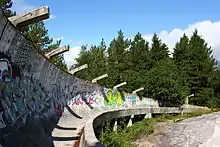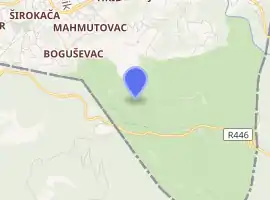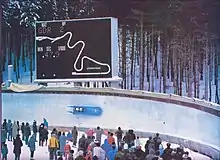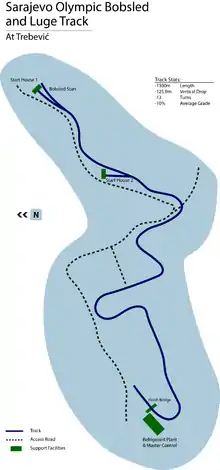Sarajevo Olympic Bobsleigh and Luge Track
Sarajevo Olympic Bobsleigh and Luge Track is a bobsleigh and luge track situated on Trebević mountain overlooking the City of Sarajevo, built for the 1984 Winter Olympics.
 Sarajevo Olympic Bobsleigh and Luge Track (with graffiti), August 2012 | |

| |
| Full name | Olimpijska staza za bob i sankanje Trebević Олимпијска стаза за боб и санкање Требевић |
|---|---|
| Location | |
| Coordinates | |
| Owner | KJP ZOI'84 OCS |
| Surface | Artificial, refrigerated concrete |
| Construction | |
| Broke ground | 1981 |
| Opened | 1982 |
| Renovated | Began 2014 Ongoing |
| Closed | 1992 |
| Construction cost | $8,500,000 USD (563,209,000 YUD) |
| Architect | Boreisa Bouchard |
History
When Sarajevo was awarded the 1984 Winter Olympics in 1977, a bobsleigh and luge track was proposed. The track design was approved in 1981, with construction starting on 1 June of that year.[1] Assembly of the track was completed on 30 September 1982 at a cost of YUD 563,209,000. The first international competition of merit held at the track was the 1983 European Bobsleigh Championships in January of that year.[2] At the 1984 Games, there were 20,000 luge spectators and 30,000 bobsleigh spectators. After the Winter Olympics, the track was used for World Cup competitions[3] until the Yugoslav wars started in 1991, which included the Bosnian War the following year. The track was damaged as a result of the Siege of Sarajevo;[4] during the siege, the track was used as an artillery position by Bosnian Serb forces.[5] The track still remains mostly intact (as of January 2018), with the war wounds of defensive fighting holes drilled into one of the last turns of the course.[6] The track has been used for graffiti and bicycling in the period between the end of the war and the commencement of renovations in 2014. In June 2014, restoration began on the track, including the removal of overgrowth and graffiti, and the application of a protective coating from Start 1 down to the bottom of the course.[7] The track is currently used for summer luge training, and other summer activities.
Design


In preparation for the 1984 Winter Olympic Games, Mt. Trebević was selected as the site for a new sliding complex. The track complex was designed by architect Boreisa Bouchard, with a vision for both reduced footprint of the facility, and flexible and adaptable use as a piece of Olympic Legacy Infrastructure.[8] The track can be split into three segments for recreational and training purposes.
When the track saw its first real competition (and a test competition ahead of the 1984 Olympic Winter Games), 1,246 heats of two- and four-man bobs were completed with just four overturns and only one serious injury reported. FIL (International Luge Federation) and FIBT (International Federation of Bobsleigh and Tobogganing) experts heralded the track as "Safe, Quick, and technically interesting and requires extreme concentration and technical knowledge."[2]
The top section, known as 'Course 1', begins at the upper start house and runs 350 meters, splitting from the main track at turn 3. With the slightest grade, it is suitable for all riders.
The center section, known as 'Course 2', begins at the second start house and runs 374 meters splitting from the main track at turn 7, after the complex and high-G 'Double S' turns (5, 6, and 7). It is more intense and complex, but still provides a good training and recreational experience of complex turning.
The bottom section, known as 'Course 3', begins below turn 7, and at 576 meters is the longest and fastest segment of the track containing some of the most complex turns in sliding: Omega, the Hairpin and the Labyrinth. Course 3 ends at the bottom of the track.[9]
Renovation

Beginning in 2014, following an extensive demining operation, limited renovations began-preparing the site for summer training with a grant from the International Luge Federation. As of January, 2018 that operation continues.[6] It is unclear when winter events will begin again due to the complete loss of both start houses and the refrigeration plant along with the extensive damage to every refrigerant and track-switching system on the track. The only remaining piece of the venue is the track itself, and is structurally in serviceable condition. However, the ultimate goal is to return the track to fully serviceable condition for hosting future sliding competitions and training teams from around the world.[10] There was talk of hosting sliding competitions for the 2019 European Youth Olympic Winter Festival, however, due to the massive cost of rebuilding much of the track's critical infrastructure, sliding events will not be run.[11][6]
Track lengths and turns
| Sport | Length (meters) | Turns | Vertical drop (start to finish) | Average grade (%) |
|---|---|---|---|---|
| Bobsleigh | 1300 | 13 | 125.90 | 10.2 |
| Luge – men's singles | 1210 | 13 | 129.35 | 10.2 |
| Luge – women's singles / men's doubles | 993 | 11 | 99.80 | 10.2 |
| Turn number | Turn name | Track gradient |
|---|---|---|
| 1 | 12% | |
| 2 | 14% | |
| 3 | 15% | |
| 4 | 15% | |
| 5 | The Double 'S' | ~14% |
| 6 | ~18% | |
| 7 | ~19% | |
| 8 | Omega | ~7% |
| 9 | ~8% | |
| 10 | The Labyrinth | ~16% |
| 11 | ||
| 12 | ||
| 13 | Finish Corner | ~16% |
Major events hosted
During its short ten-year operational history, the track hosted a number of high-profile sliding events.
| Year | Event |
|---|---|
| 1983 | Bobsleigh European Championships |
| 1984 | XIV Olympic Winter Games |
| 1985 | Skeleton European Championship |
| 1987 | Skeleton European Championship |
| 1988 | Bobsleigh European Championship |
See also
- Bjelašnica – Alpine skiing (men)
- Igman, Malo Polje – Nordic combined, Ski jumping
- Igman, Veliko Polje – Biathlon, Cross-country skiing, Nordic combined
- Jahorina – Alpine skiing (women)
- Koševo Stadium – Opening ceremonies
- Skenderija II Hall – Figure skating, Ice hockey
- Zetra Ice Hall – Closing ceremonies, Figure skating, Ice hockey
- Zetra Ice Rink – Speed skating
References
- 1984 Winter Olympics official report. pp. 61, 64-70, 107, 180, 184. (in English, French, and Serbo-Croatian) - accessed 26 February 2008.
- Selamić, Sabahudin (1983). Illustrated Review of the Organizing Committee of the XVI Olympic Winter Games. Sarajevo, Yugoslavia: Organizing Committee of the XVI Olympic Winter Games. p. 20.
- Artificial track World Cup victors since 1978, including Sarajevo (1984-90) (in German) - accessed 26 February 2008.
- Winterblue.de track of Sarajevo mentioning the track's destruction Archived 2012-02-10 at the Wayback Machine(in German) - accessed 23 February 2008.
- Wallechinsky, David and Jaime Loucky (2009). The Complete Book of the Winter Olympics: 2010 Edition. London: Aurum Press. p. 7.
- "Ruined and neglected, Sarajevo tracks still hold hope for some". Reuters. 17 January 2018. Retrieved 2018-02-12.
- Fincher, Julia (2014-07-04). "Ruined Olympic luge track in Sarajevo to be restored". OlympicTalk. Retrieved 2017-01-19.
- westnyacktwins (2011-08-02), 1984 Winter Olympics - Two-man Bobsled 2nd run - Part 1, retrieved 2017-01-20
- westnyacktwins (2011-12-26), 1984 Winter Olympics - Four-man Bobsled Run 1 Part 2, retrieved 2017-01-20
- "Possibility for the Reconstruction of Sled, Bobsled and Skeleton Tracks on Trebević Mt.? - Sarajevo Times". Sarajevo Times. 2015-05-30. Retrieved 2017-01-19.
- "European Youth Olympics Festival » 2019 Winter (Sarajevo)". www.eyof.org. Retrieved 2017-01-19.
- westnyacktwins (2011-12-26), 1984 Winter Olympics - Four-man Bobsled Run 1 Part 1, retrieved 2017-01-20
External links
| Wikimedia Commons has media related to Sarajevo bobsleigh and luge track. |

